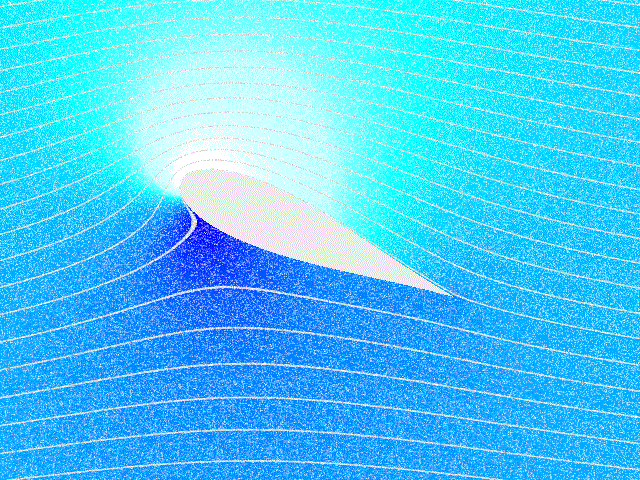|
MUSCL Scheme
In the study of partial differential equations, the MUSCL scheme is a finite volume method that can provide highly accurate numerical solutions for a given system, even in cases where the solutions exhibit shocks, discontinuities, or large gradients. MUSCL stands for ''Monotonic Upstream-centered Scheme for Conservation Laws'' (van Leer, 1979), and the term was introduced in a seminal paper by Bram van Leer (van Leer, 1979). In this paper he constructed the first ''high-order'', ''total variation diminishing'' (TVD) scheme where he obtained second order spatial accuracy. The idea is to replace the piecewise constant approximation of Godunov's scheme by reconstructed states, derived from cell-averaged states obtained from the previous time-step. For each cell, slope limited, reconstructed left and right states are obtained and used to calculate fluxes at the cell boundaries (edges). These fluxes can, in turn, be used as input to a '' Riemann solver'', following which the solutions ... [...More Info...] [...Related Items...] OR: [Wikipedia] [Google] [Baidu] |
Partial Differential Equation
In mathematics, a partial differential equation (PDE) is an equation which imposes relations between the various partial derivatives of a multivariable function. The function is often thought of as an "unknown" to be solved for, similarly to how is thought of as an unknown number to be solved for in an algebraic equation like . However, it is usually impossible to write down explicit formulas for solutions of partial differential equations. There is, correspondingly, a vast amount of modern mathematical and scientific research on methods to numerically approximate solutions of certain partial differential equations using computers. Partial differential equations also occupy a large sector of pure mathematical research, in which the usual questions are, broadly speaking, on the identification of general qualitative features of solutions of various partial differential equations, such as existence, uniqueness, regularity, and stability. Among the many open questions are the e ... [...More Info...] [...Related Items...] OR: [Wikipedia] [Google] [Baidu] |
High Resolution Scheme
High-resolution schemes are used in the numerical solution of partial differential equations where high accuracy is required in the presence of shocks or discontinuities. They have the following properties: *Second- or higher-Order of accuracy, order spatial accuracy is obtained in smooth parts of the solution. *Solutions are free from spurious oscillations or wiggles. *High accuracy is obtained around shocks and discontinuities. *The number of mesh points containing the wave is small compared with a first-order scheme with similar accuracy. General methods are often not adequate for accurate resolution of steep gradient phenomena; they usually introduce non-physical effects such as ''smearing'' of the solution or ''spurious oscillations''. Since publication of ''Godunov's order barrier theorem'', which proved that linear methods cannot provide non-oscillatory solutions higher than first order (Godunov 1954, Godunov 1959), these difficulties have attracted much attention and a nu ... [...More Info...] [...Related Items...] OR: [Wikipedia] [Google] [Baidu] |
Finite Volume Method
The finite volume method (FVM) is a method for representing and evaluating partial differential equations in the form of algebraic equations. In the finite volume method, volume integrals in a partial differential equation that contain a divergence term are converted to surface integrals, using the divergence theorem. These terms are then evaluated as fluxes at the surfaces of each finite volume. Because the flux entering a given volume is identical to that leaving the adjacent volume, these methods are conservative. Another advantage of the finite volume method is that it is easily formulated to allow for unstructured meshes. The method is used in many computational fluid dynamics packages. "Finite volume" refers to the small volume surrounding each node point on a mesh. Finite volume methods can be compared and contrasted with the finite difference methods, which approximate derivatives using nodal values, or finite element methods, which create local approximations of a solut ... [...More Info...] [...Related Items...] OR: [Wikipedia] [Google] [Baidu] |
AUSM
Auckland University of Technology (AUT) ( mi, Te Wānanga Aronui o Tāmaki Makau Rau) is a university in New Zealand, formed on 1 January 2000 when a former technical college (originally established in 1895) was granted university status. AUT is New Zealand's third largest university in terms of total student enrolment, with approximately 29,100 students enrolled across three campuses in Auckland. It has five faculties, and an additional three specialist locations: AUT Millennium, Warkworth Radio Astronomical Observatory and AUT Centre for Refugee Education. AUT enrolled more than 29,000 students in 2018, including 4,194 international students from 94 countries and 2,417 postgraduate students. AUT's student population is diverse with a range of ethnic backgrounds including New Zealand European, Asian, Māori and Pasifika. Students also represent a wide age range with 22% being aged 25–39 years and 10% being 40 or older. AUT employed 2,474 full-time equivalent (FTE) staff in ... [...More Info...] [...Related Items...] OR: [Wikipedia] [Google] [Baidu] |
Shock Tube
: ''For the pyrotechnic initiator, see Shock tube detonator'' The shock tube is an instrument used to replicate and direct blast waves at a sensor or a model in order to simulate actual explosions and their effects, usually on a smaller scale. Shock tubes (and related impulse facilities such as shock tunnels, expansion tubes, and expansion tunnels) can also be used to study aerodynamic flow under a wide range of temperatures and pressures that are difficult to obtain in other types of testing facilities. Shock tubes are also used to investigate compressible flow phenomena and gas phase combustion reactions. More recently, shock tubes have been used in biomedical research to study how biological specimens are affected by blast waves. A shock wave inside a shock tube may be generated by a small explosion (blast-driven) or by the buildup of high pressures which cause diaphragm(s) to burst and a shock wave to propagate down the shock tube (compressed-gas driven). History An earl ... [...More Info...] [...Related Items...] OR: [Wikipedia] [Google] [Baidu] |
Equation Of State
In physics, chemistry, and thermodynamics, an equation of state is a thermodynamic equation relating state variables, which describe the state of matter under a given set of physical conditions, such as pressure, volume, temperature, or internal energy. Most modern equations of state are formulated in the Helmholtz free energy. Equations of state are useful in describing the properties of pure substances and mixtures in liquids, gases, and solid states as well as the state of matter in the interior of stars. Overview At present, there is no single equation of state that accurately predicts the properties of all substances under all conditions. An example of an equation of state correlates densities of gases and liquids to temperatures and pressures, known as the ideal gas law, which is roughly accurate for weakly polar gases at low pressures and moderate temperatures. This equation becomes increasingly inaccurate at higher pressures and lower temperatures, and fails to predi ... [...More Info...] [...Related Items...] OR: [Wikipedia] [Google] [Baidu] |
Euler Equations (fluid Dynamics)
In fluid dynamics, the Euler equations are a set of quasilinear partial differential equations governing adiabatic and inviscid flow. They are named after Leonhard Euler. In particular, they correspond to the Navier–Stokes equations with zero viscosity and zero thermal conductivity. The Euler equations can be applied to incompressible or compressible flow. The incompressible Euler equations consist of Cauchy equations for conservation of mass and balance of momentum, together with the incompressibility condition that the flow velocity is a solenoidal field. The compressible Euler equations consist of equations for conservation of mass, balance of momentum, and balance of energy, together with a suitable constitutive equation for the specific energy density of the fluid. Historically, only the equations of conservation of mass and balance of momentum were derived by Euler. However, fluid dynamics literature often refers to the full set of the compressible Euler equations ... [...More Info...] [...Related Items...] OR: [Wikipedia] [Google] [Baidu] |


